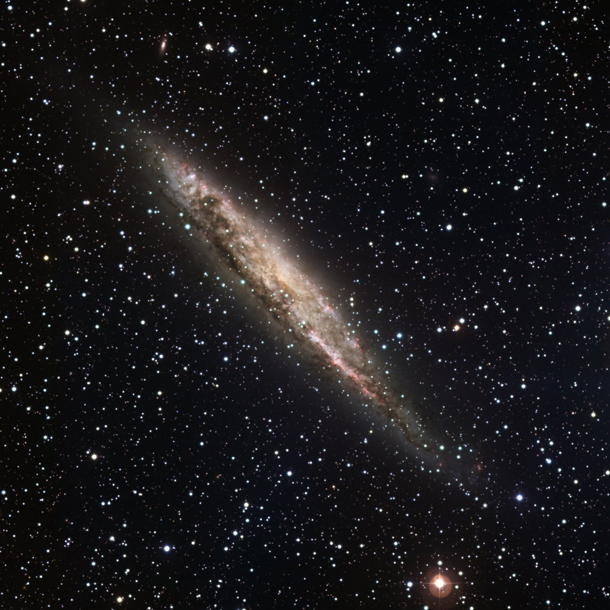Hey, it’s been a while since I posted a really pretty deep space picture just for the heck of it. So here you go: the magnificent spiral galaxy NGC 4945:
 |
| NGC 4945. Image Credit: ESO. Click to embiggenatrify. |
Wow. This image was taken using the European Southern Observatory’s 2.2-meter MPG/ESO telescope in La Silla, Chile. The picture uses five filters: three to mimic what the eye sees (red, green, and blue) plus two more which let through light emitted by hydrogen and sulfur. Those last two filters emphasize light given off in giant gas clouds that are actively forming stars. You can see that in the image as the streaks of pinkish light around the edge of the galaxy.
But there’s more going on here than meets the eye…
NGC 4945 is about 13 million light years away in the constellation of Centaurus. All the stars you see in the image are in our own Milky Way galaxy; it’s a little bit like looking through a dirty window at an object outside. Looking in this direction means looking right through a local spiral arm of the Milky Way, so we see lots of foreground stars interfering with our view… but it makes the image prettier.
This galaxy is an interesting one to study. First, it’s a lot like the Milky Way, a spiral galaxy with hundreds of billions of stars. Second, it’s close to us, making it easy to study. We have a great view of it! To give you a sense of scale, the full Moon would just fit in this image, so we really can see very fine detail in the galaxy. In fact, a search of the professional journal papers indicates it’s one of the most studied galaxies in the sky.
Even better, NGC 4945 is an active galaxy, meaning it’s shooting high-energy light and matter out of its nucleus. You can’t tell in this picture because there are thousands of light years of gas and dust inside the galaxy blocking our visible-light view of the center. But X-rays, for example, slice right through all that junk, and in fact NGC 4945 is one of the brightest extragalactic X-ray sources in the sky. Even cooler, radio observations of the core of the galaxy reveal it has a ring of intense star formation occurring just 160 light years from the galactic nucleus!
That’s incredible, because the fact that NGC 4945 is active means it has a supermassive black hole at its core which is busily gobbling down matter at an atrocious rate. It doesn’t seem at first blush like the best environment to make new stars… but you need to drill down a bit here. Matter spiraling down into a black hole heats up monstrously due to friction, magnetism, and other forces, and a wind of subatomic particles can blast out from the material. If there is an abundance of gas and dust near the center of the galaxy – and radio observations indicate there is – then this wind slams into that material, compressing and collapsing it, forming stars.
Think for a moment on that: in the deepest hearts of galaxies, sometimes the place where matter goes to die – and directly because that matter is disappearing for ostensibly forever – is also where new stars are born.
I don’t believe there is a driving force to this Universe, no guidance or hand at the wheel… but it still gets to me sometimes, just how poetic a cosmos it is that we live in.